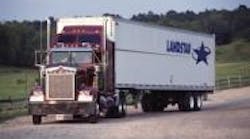“This marked the first time since the third quarter of 2008 where revenue in the current quarter increased over the corresponding quarter in the prior year.” –Henry Gerkens, chairman, president and CEO of Landstar System, Inc.
While the improvements in the freight market are nowhere near universal – LTL carriers, in particular, will still find rough waters ahead – things seem to be improving out there. While many carriers might not agree, reports from several of their peers seem to indicate better days might finally (at long last) be arriving.
"The freight environment continues to improve,” noted Henry Gerkens, chairman, president and CEO of Landstar System, Inc., in the carrier’s first quarter earnings report. “Recent trends in March, and thus far in April, indicate that both the revenue per load and the number of loads hauled remain strong compared to the corresponding prior year periods. I expect these trends to continue throughout the 2010 second quarter.”
Landstar said its revenue increase 17% to $548.1 million in the first quarter, this year, up from $469.2 million in the same quarter during 2009. Net income also popped up in the first quarter, to $17.2 million compared to $13.9 million in the same period last year.
“This marked the first time since the third quarter of 2008 where revenue in the current quarter increased over the corresponding quarter in the prior year,” Gerkins said. “That … was primarily the result of an 18% increase in the number of loads hauled, which was partly offset by lower revenue per load of approximately 2%, compared to the first quarter of 2009.”
As an aside, Gerkins pointed out that the number of loads hauled by Landstar’s owner-operators during the month of March this year was the highest number of loads hauled by them in March of any year in Landstar's history. “Also, in March 2010, we experienced the first month-over-prior-year-month increase in revenue per load on freight hauled by Landstar’s [owner-operators] since 2008.”
“We expected the first quarter to be the most challenging of 2010 as the economic recovery gathered steam through the year,” said Kurt Kuehn, chief financial officer for United Parcel Service. “As it turned out, revenue was stronger than we expected due to international volume gains, increased yields in the U.S. and growth in [freight] forwarding and logistics [operations]. Also, the operating leverage in our streamlined network provided higher margins than anticipated.”
Kuehn said things are so much better that UPS boosted its earnings per share by 37% for the first quarter of 2010 – to 71 cents per diluted share compared to 52 cents per share in the same period in 2009. That’s because UPS’s consolidated revenue for the first quarter grew 7%, driven by increases of 18% in its international package and 14% in supply chain and freight divisions.
UPS’s international daily volumes grew significantly with export up more than 9% and non-U.S. domestic up over 24%. While U.S. domestic daily volume increased less than 1%, it was the first year-over-year growth in domestic volumes in more than two years, Kuehn pointed out.
“We’re definitely seeing positive trends in [truck capacity] demand developing,” Brett Terchila, director of operations for truckload carrier Transport America, told me. “It’s not a completely solid demand uptick, but we’re definitely seeing more consistent freight volumes now week to week.”
As a result, Transport America was able to “seat” 50 more trucks over the last four weeks.
“We’re seeing in particular significant demand from ‘ad hoc’ freight and that brokers are paying higher, as well paying to reposition equipment,” Terchila added. “Shipper inventories remain low, so they will have to start restocking. As a result, our truck utilization rates – both month-over-month and year-over-year – are definitely increasing.”
All I can say is, let’s hope these trends continue to strengthen.






